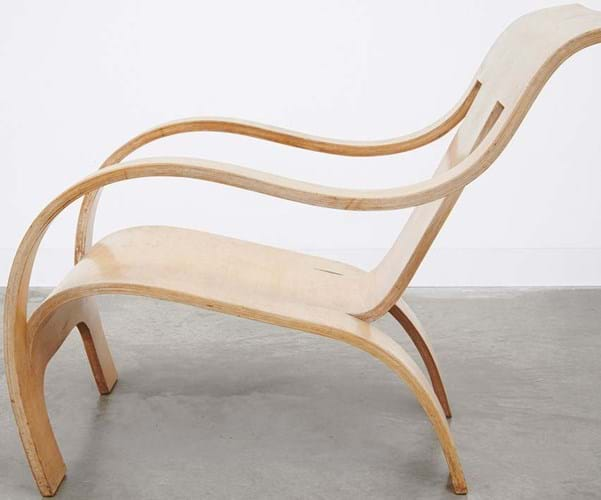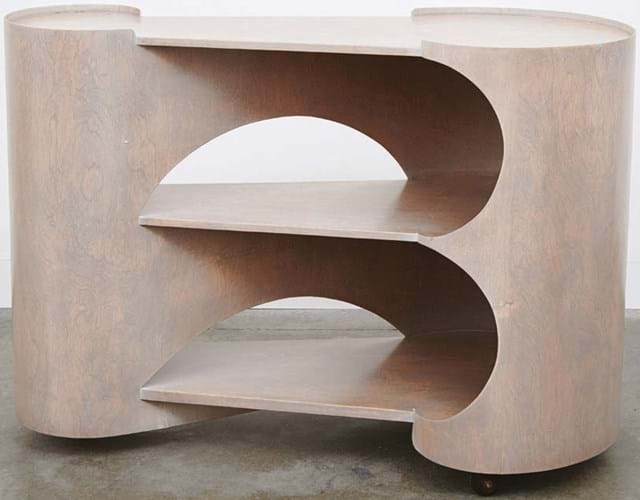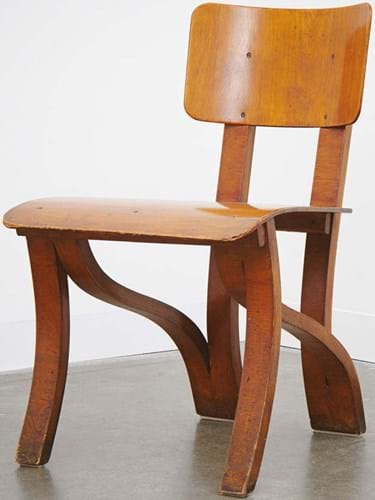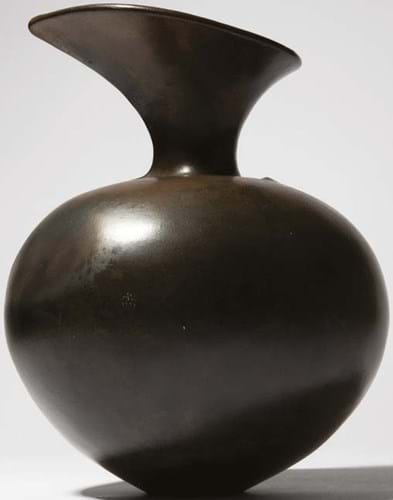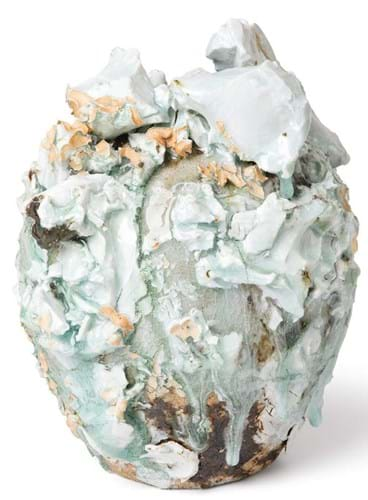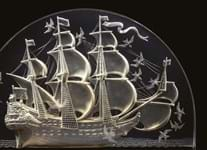A collection of plywood furniture by English Modernist designer Gerald Summers (1899-1967) – the largest of its type to come to auction – proved a sell-out when offered for sale in London.
The Modern Made sale held by Lyon & Turnbull (26% buyer’s premium) at the Mall Galleries on October 28 included 23 pieces of 1930s furniture by Summers from a collector who has long championed his work.
Summers and his partner Marjorie Butcher opened their London shop, Makers of Simple Furniture, in 1931.
For a decade, until the firm closed with the onset of the Second World War, it produced more than 200 designs conceived in the Modernist creed as ‘furniture for the concrete age’.
The emphasis was very much on function, modern materials and machine methods of manufacture. Having worked as an apprentice within the aviation industry, Summers had seen the benefits of birch plywood that could be versatile, strong and cheap but also avant garde.
He sold his furniture to forward-thinking members of the British public through department stores and furnishing shops in London, such as Heal’s.
Largely forgotten
Like so much of British inter-war design, Summers’ work was largely forgotten by the market until the advent of the 21st century.
His reputation in particular had paled in comparison with contemporaries such as Marcel Breuer (whose Isokon long chair was designed in 1936) or Alvar Aalto (designer of the Paimio chair in 1932) who worked in much the same medium.
However, today Summers is increasingly seen as a pioneer and his works the precursor to the ubiquitous moulded plywood chairs made later in the century by Charles and Ray Eames. Martha Deese, an authority on Summers who provided the introduction to the catalogue, will publish a book on Simple Furniture next year. Deese says: “Despite the quality and ubiquity of his furniture, Gerald did not receive the same level of critical acclaim in his day as established designers. This was due, in part, to his distaste for self-promotion.
“It was the satisfaction of a design problem deftly resolved – an elegantly proportioned sideboard, an effervescent barstool – that interested him, not the accolades. What he cared about most was the satisfaction that his furniture brought to the firm’s clients.”
Ingenious vision
The collection included a fine example of Summers’ best-known design, his armchair c.1933-34 made from a single sheet of birch plywood.
Summers had the ingenious vision to construct a chair that would dispense of any extraneous fixings, require no joins and create very little waste, relying instead on simple incisions and mould bending.
In a 1935 interview with Design for Today he observed: “In pure design we expect each part and member to pull its full weight in making the design suitable for its purpose… if we use a brace only to strengthen two members the design is bad.”
The example here was purchased new by the Oxford artist Juliette May Lucille Edwards (1909-2011) and acquired by the vendor from her estate in 2011. It was estimated at £7000-9000 but sold for £20,000.
Other examples of the chair have appeared for sale in London in recent years – selling for between £10,000- 25,000 depending on condition and provenance. Another is up for auction on December 7-8 at Mallams in Oxford with a guide of £8000- 12,000.
An example of Summers’ work sold at L&T with a provenance to its original owner was a set of three nesting tables, c.1935, sold at £5500. These came by descent from Cecil Handisyde (b.1908), one of a team of architects who designed the Lansbury Estate in Tower Hamlets, London. The first phase of building was undertaken as the ‘live architecture’ element of the 1951 Festival of Britain exhibition.
A stained ash plywood and brass trolley, c.1936, was Summers’ only documented design for Isokon, the design firm founded by Jack Pritchard and Welles Coates. Both Isokon and Simple Furniture used the same birch plywood manufacturer Venesta in their furniture making.
Although a series of copies have been produced this century, only 20 or so original trolleys were thought to have been made before plywood became difficult to source with the onset of the Second World War.
A similar piece (perhaps this one) featured in the Bent Wood and Metal Furniture 1850-1946 exhibition organised by The American Federation of Arts which travelled to nine institutions around the US in the 1980s. Estimated at £12,000- 18,000, it sold for £28,000.
To P or not to P
Another particularly rare piece is a Type P chair with legs formed from single strips of bent plywood, which rise to form the back supports.
The Italian architect and designer Carlo Mollino created a pair of plywood chairs for the Casa Cattaneo using a similar technique two decades later.
This is believed to be the only example of this Summers chair to exist, though it is known that two were originally produced. It was described in the Makers of Simple Furniture advertising as: “Suitable for occasional or dining use. Constructed of selected birch and finished in clear polish.”
The Type P chair sold for £18,000. Collectively the Summers lots received bids from the UK, the US and China.
Odundo at £180,000
The Modern Made sale, a format that blends together art and objects from progressive design movements of the past century, was also memorable for a fine array of studio wares by Post-war and Contemporary female potters.
Foremost among these was a signature vase by Kenyan-born ceramicist Dame Magdalene Odundo (b.1950) whose work now enjoys the sort of financial rewards shared only by a small handful of post-war studio potters.
The 11in (27.5cm) high Untitled Vessel from 1986, painstakingly fashioned in the burnished and carbonised terracotta that is Odundo’s signature medium, assumes an asymmetrical form evocative of the human body.
It was acquired by the vendor at auction more than 25 years ago at a time when the market was in relative infancy. Here, estimated at a modest £10,000-15,000, it sold for a mighty £180,000.
This was the second-highest price paid for the potter who (courtesy of a similar vase sold by Maak in 2020 for £200,000) holds the auction record for a work by any living ceramic artist.
A much simpler form by Odundo, a burnished and carbonised terracotta bowl, sold for £25,000 at L&T. It had formed part of the Royal College of Art Degree Show, London, 1982 where it was acquired by the vendor.
The Anglo-Japanese potter Akiko Hirai (b.1970) is among the more admired of the current generation of contemporary ceramicists, blending Japanese and British pottery techniques results in her celebrated, asymmetrical natural forms.
The sale included 12 lots from across her career that began in London at the turn of the 21st century. They ranged from a group of 12 ‘Morandi’ stoneware bottles (socalled as they mirror the bottles and jars used by Italian artist Giorgio Morandi in his still-life paintings) sold at £2800 to a series of the grogged stoneware vessels inspired by the Korean pots that shock and surprise with their rugged surfaces and ash glazes.
A 19in (48cm) ‘Moon’ jar bought by the vendor at the exhibition Akiko Hirai: In Praise of Shadows at The Scottish Gallery, Edinburgh, in 2017 took £5500.


